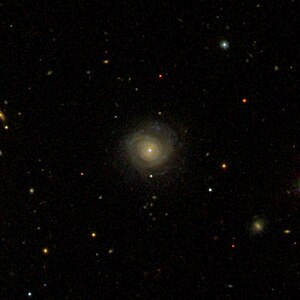NGC 3080
| Galaxy NGC 3080 |
|
|---|---|

|
|
| SDSS recording | |
| AladinLite | |
| Constellation | lion |
|
Position equinox : J2000.0 , epoch : J2000.0 |
|
| Right ascension | 09 h 59 m 55.8 s |
| declination | + 13 ° 02 ′ 38 ″ |
| Appearance | |
| Morphological type | Sa / Sy1 |
| Brightness (visual) | 13.6 mag |
| Brightness (B-band) | 14.5 mag |
| Angular expansion | 0.9 ′ × 0.8 ′ |
| Position angle | 69 ° |
| Surface brightness | 13.1 mag / arcmin² |
| Physical data | |
| Affiliation | WBL 246-004 |
| Redshift | 0.035428 ± 0.000133 |
| Radial velocity | 10,621 ± 40 km / s |
|
Stroke distance v rad / H 0 |
(470 ± 33) · 10 6 Lj (144.0 ± 10.1) Mpc |
| history | |
| discovery | William Herschel |
| Discovery date | April 1, 1794 |
| Catalog names | |
| NGC 3080 • UGC 05372 • PGC 28910 • CGCG 064-025 • MCG + 02-26-015 • IRAS F09572 + 1316 • 2MASX J09595588 + 1302381 • Mrk 1243 • GC 1984 • H III 934 • GALEX ASC J095955.84 + 130238.1 • USGC U272 NED01 | |
NGC 3080 is a spiral galaxy with an active nucleus of the Hubble type Sa in the constellation Leo on the ecliptic . It is estimated to be 470 million light years from the Milky Way and about 125,000 light years across.
In the same area of the sky is u. a. the galaxy IC 585 .
The object was discovered by William Herschel on April 1, 1794 .
